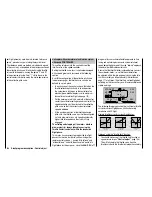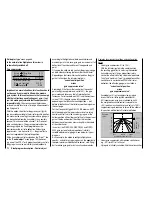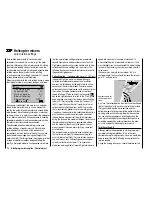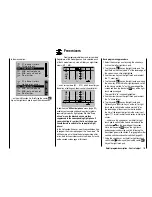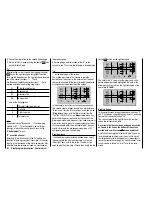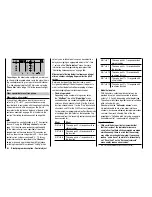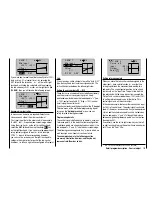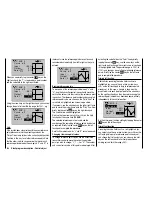
173
Detail program description - Control adjust
control limits. Here too, for purposes of illustration, we
plot gyro gain values in relation to tail rotor defl ection
for various parameter values of gyro suppression.
Exemple:
+80 %
Í
Gyro gain
Î
left
Stick deflection tail rotor
centre
right
Range of
tr
ansmitter
control 7
Adjusting the gyro sensor
To achieve the maximum possible level of stabilization
for the helicopter with the gyro along the vertical axis,
observe the following:
The controls should have as little friction and "play"
•
as possible.
There should be no "spring" in the control linkage.
•
Use a strong and – in particular – a fast servo
•
When the gyro sensor detects a model rotation, the
faster its response – a corresponding corrective change
to tail rotor thrust – takes effect, the further the gyro
gain adjustor can be moved without causing the tail of
the model to start oscillating, and the better the model's
stability about its vertical axis. If the response is slower,
there is a risk that the model's tail will start to oscillate
even at low gyro gain settings. Here, further reductions
to gyro gain will need to be made to eliminate the
oscillation.
If the model is fl ying forward at high speed or hovering
in a powerful headwind, the net result of the stabilizing
effect of the vertical fi n combined with the gyro may
also lead to an overreaction that once again manifests
itself through tail oscillation. To achieve optimum gyro
stabilization under all conditions, you can make use of
the option to adjust gyro gain from the transmitter using
a transmitter control assigned to input "7", in connection
with gyro suppression and/or the two settings on the
Gyro NEJ-120 BB.
Further notes on gyros with confi gurable multilevel gyro
gain (e. g. NEJ-120 BB)
Since you cannot specify the gyro gain from the
transmitter proportionally via the transmitter control, the
gyro's own control 1 must be used to set the (weaker)
gyro gain (e. g. for aerobatics) and control 2 the stronger
gyro gain (e. g. for hovering ). Even though a proportional
rotary control is used for control function 7, only a
switch-over between these two values takes place and
the setting is therefore not proportional.
You should therefore advance control 2 to the point
where the model is on the brink of oscillating when
hovering in calm conditions, and advance control 1 to
the point where the model does not oscillate with its
tail even when fl ying at maximum speed into a strong
headwind. Depending on the state of the weather
and the fl ight program planned, you can also switch
over the gyro gain from the transmitter – also with
gyro suppression dependent on tail rotor defl ection if
required.
Swashplate rotation
0%
0%
SEL
0%
0°
Nick
Throttle
Nick
Tail
Swash rotation
Swash limiter
OFF
Nor mal
Gyro suppress
Some rotor head control systems make it necessary
to incline the swashplate in a different direction from
the intended inclination of the rotor plane when a cyclic
control command is given. If your model features a
four-bladed main rotor, for example, you may need to
use this menu to set up a software-driven 45° rotation
of the control linkage to the right, so that the pushrods
from the swashplate to the rotor head can be set exactly
vertical, ensuring that the blade control system works
correctly, without unwanted differential effects. This
eliminates the need to make mechanical changes to
the control linkages. Negative angles equate to a virtual
rotation of the rotor head to the left; positive angles a
virtual rotation to the right.
Swashplate limiting
0%
0%
SEL
0%
0°
Nick
Throttle
Nick
Tail
Swash rotation
Swash limiter
OFF
Nor mal
Gyro suppress
This function works like a circular mechanical surround
acting upon the stick which controls the swashplate,
restricting the normally square stick travel to a circular
range. In fact, if the helicopter is set up in such a way
Summary of Contents for mx-20 Hott
Page 41: ...41 Your notes...
Page 49: ...49 Your notes...
Page 55: ...55 Your notes...
Page 81: ...81 Your notes...
Page 85: ...85 Your notes...
Page 89: ...89 Your notes...
Page 99: ...99 Detail program description Control adjust...
Page 127: ...127 Detail program description Control adjust...
Page 131: ...131 Detail program description Control adjust...
Page 163: ...163 Detail program description Control adjust...
Page 191: ...191 Detail program description Control adjust...
Page 207: ...207 Detail program description Control adjust...
Page 228: ...228 Detail program description Control adjust...
Page 229: ...229 Detail program description Control adjust...
Page 251: ...251 Detail program description Control adjust...










